Mitsubishi ASX 2018 Owner's Manual

OGAE18E1 - ENGLISH - ASX
ASX
OWNER’S MANUAL
ASX - ENGLISH - OGAE18E1

Foreword
E09200107208
Thank you for selecting an ASX as your new vehicle.
This owner’s manual will add to your understanding and full enjoyment of the many fine features of this vehicle.
It contains information prepared to acquaint you with the proper way to operate and maintain your vehicle for the utmost in driving pleasure.
MITSUBISHI MOTORS Europe B.V. reserves the right to make changes in design and specifications and/or to make additions to or improvements in this product without obligation to install them on products previously manufactured.
It is an absolute requirement for the driver to strictly observe all laws and regulations concerning vehicles.
This owner’s manual has been written in compliance with such laws and regulations, but some of the contents may become contradictory with later amendment of the laws and regulations.
Please leave this owner’s manual in this vehicle at time of resale. The next owner will appreciate having access to the information contained in this owner’s manual.
Repairs to your vehicle: Vehicles in the warranty period:
All warranty repairs must be carried out by a MITSUBISHI MOTORS Authorized Service Point.
Vehicles outside the warranty period:
Where the vehicle is repaired is at the discretion of the owner.
Throughout this owner’s manual the words WARNING and CAUTION appear.
These serve as reminders to be especially careful. Failure to follow instructions could result in personal injury or damage to your vehicle.
 WARNING
WARNING
Indicates a strong possibility of severe personal injury or death if instructions are not followed.
 CAUTION
CAUTION
Means hazards or unsafe practices that could cause minor personal injury or damage to your vehicle.
 NOTE
NOTE
Gives helpful information.
You will see another important symbol:
*: indicates optional equipment.
It may differ according to the sales classification; refer to the sales catalogue.
Abbreviations used in this owner’s manual:
LHD: Left-Hand Drive |
M/T: Manual Transmission |
RHD: Right-Hand Drive |
A/T: Automatic Transmission |
|
CVT: Continuously Variable |
|
Transmission |
The symbol used on the vehicles:  : See owner’s manual
: See owner’s manual
© 2017 Mitsubishi Motors Corporation
Information for station service
E09300104660
|
|
|
2WD models |
58 litres*1 |
|
|
Petrol-powered vehicles |
63 litres*2 |
|
|
Capacity |
|
||
|
|
4WD models |
60 litres |
|
|
|
|
||
|
|
|
|
|
|
|
Diesel-powered vehicles |
|
60 litres |
Fuel |
|
Petrol-powered vehicles |
|
|
|
|
Unleaded petrol octane number (EN228) |
|
|
|
Recommended |
1600 models, 1800 models: 95 RON or higher |
|
|
|
2000 models: 90 RON or higher |
|
||
|
fuel |
|
||
|
Diesel-powered vehicles |
|
||
|
|
|
||
|
|
Cetane number (EN590): 51 or higher |
|
|
|
|
Refer to the “General information” section for the fuel selection. |
|
|
Engine oil |
Refer to the “Maintenance” section for the selection of engine oil. |
|
||
Tyre inflation pressure |
Refer to the “Maintenance” section for the tyre inflation pressure. |
|
||
|
|
|
|
|
*1: For vehicles with vehicle identification numbers that begin with “4” *2: For vehicles with vehicle identification numbers that begin with “J”
 CAUTION
CAUTION
•Diesel-powered vehicles are designed to use only diesel fuel that meets the EN 590 standard. Use of any other type of diesel fuel can adversely affect the engine.
 NOTE
NOTE
• For the location of the vehicle identification number, refer to “Vehicle identification number” on page 11-02.
OGAE18E1 18
BLO-17-000482

Table of contents
Overview |
|
1 |
|
|
|
General information |
2 |
|
|
|
|
Locking and unlocking |
3 |
|
|
|
|
Seat and seat belts |
4 |
|
|
|
|
Instruments and controls |
5 |
|
|
|
|
Starting and driving |
6 |
|
|
|
|
For pleasant driving |
7 |
|
|
|
|
For emergencies |
8 |
|
|
|
|
Vehicle care |
9 |
|
|
|
|
Maintenance |
10 |
|
|
|
|
Specifications |
11 |
|
|
|
|
Alphabetical index |
12 |
|
|
|
|
Declaration of Conformity |
13 |
OGAE18E1

Instruments and controls
1Instruments and controls
|
|
|
E00100109149 |
|
|
1. |
Combination headlamps and dipper switch p. 5-50 |
|
|
|
Turn-signal lever p. 5-57 |
|
|
|
Front fog lamp switch* p. 5-58 |
|
|
|
Rear fog lamp switch p. 5-58 |
|
|
2. |
Instruments p. 5-02 |
|
|
3. |
Shift paddles* p. 6-36 |
|
|
4. |
Windscreen wiper and washer switch p. 5-59 |
|
|
|
Rear window wiper and washer switch p. 5-63 |
|
|
|
Headlamp washer switch* p. 5-64 |
|
|
5. |
Engine switch* p. 3-13 |
|
|
6. |
Cruise control switch* p. 6-54 |
|
|
7. |
Ignition switch* p. 6-12 |
|
|
8. |
Supplemental restraint system (SRS) - driver’s knee airbag* |
|
|
|
p. 4-29 |
|
|
9. |
Supplemental restraint system (SRS) - airbag (for driver’s seat) |
|
|
|
p. 4-24, 4-29 |
|
|
|
Horn switch p. 5-65 |
|
|
10. |
Tilt & Telescopic steering lever p. 6-08 |
|
|
11. |
Bluetooth® 2.0 interface* p. 7-46 |
|
|
12. |
Steering wheel audio remote control switches* p. 7-23 |
|
|
13. |
Sonar switch* p. 6-79 |
|
|
14. |
Lane Departure Warning (LDW)* p. 6-68 |
|
|
15. |
FCM ON/OFF switch* p. 6-63 |
|
|
16. |
Headlamp levelling switch* p. 5-55 |
1-02 |
Overview |
OGAE18E1 |
|

Instruments and controls
1
1. |
Instruments p. 5-02 |
|
2. |
Windscreen wiper and washer switch p. 5-59 |
|
|
Rear window wiper and washer switch p. 5-63 |
|
|
Headlamp washer switch* p. 5-64 |
|
3. |
FCM ON/OFF switch* p. 6-63 |
|
4. |
Headlamp levelling switch* p. 5-55 |
|
5. |
Lane Departure Warning (LDW)* p. 6-68 |
|
6. |
Sonar switch* p. 6-79 |
|
7. |
Cruise control switch* p. 6-54 |
|
8. |
Supplemental restraint system (SRS) - airbag (for driver’s seat) |
|
|
p. 4-24, 4-29 |
|
|
Horn switch p. 5-65 |
|
9. |
Ignition switch* p. 6-12 |
|
10. |
Supplemental restraint system (SRS) - driver’s knee airbag* |
|
|
p. 4-29 |
|
11. |
Bluetooth® 2.0 interface* p. 7-46 |
|
12. |
Steering wheel audio remote control switches* p. 7-23 |
|
13. |
Tilt & Telescopic steering lever p. 6-08 |
|
14. |
Engine switch* p. 3-13 |
|
15. |
Combination headlamps and dipper switch p. 5-50 |
|
|
Turn-signal lever p. 5-57 |
|
|
Front fog lamp switch* p. 5-58 |
|
|
Rear fog lamp switch p. 5-58 |
|
16. |
Shift paddles* p. 6-36 |
|
OGAE18E1 |
Overview |
1-03 |

Instruments and controls
1
|
|
1. |
Audio system* p. 7-11 |
|
|
|
MITSUBISHI Multi-Communication System* |
|
|
|
DISPLAY AUDIO* |
|
|
|
Smartphone Link Display Audio* |
|
|
|
Refer to the separate owner’s manual |
|
|
2. |
Centre ventilators p. 7-02 |
|
|
3. |
Key slot* p. 3-20 |
|
|
4. |
Side ventilators p. 7-02 |
|
|
5. |
Front passenger’s airbag ON-OFF switch p. 4-27 |
|
|
|
Glove box p. 7-76 |
|
|
6. |
Hazard warning flasher switch p. 5-57 |
|
|
7. |
Rear window demister switch p. 5-64 |
|
|
8. |
Drive mode selector* p. 6-39 |
|
|
9. |
Gearshift or selector lever p. 6-23, 6-26, 6-33 |
|
|
10. |
Parking brake lever p. 6-06 |
|
|
11. |
Cup holder p. 7-79 |
|
|
12. |
Ashtray* p. 7-71 |
|
|
13. |
Fuel tank filler door release lever p. 2-03 |
|
|
14. |
Bonnet release lever p. 10-03 |
|
|
15. |
Fuse box p. 10-19 |
|
|
16. |
Accessory Socket* p. 7-72 |
|
|
|
Cigarette lighter* p. 7-71 |
|
|
17. |
Auto Stop & Go (AS&G) OFF switch* p. 6-19 |
|
|
18. |
Heated seat switch* p. 4-06 |
|
|
19. |
USB input terminal* p. 7-67 |
|
|
20. |
Active stability control (ASC) OFF switch* p. 5-04 |
|
|
21. |
Multi-information meter switch p. 5-04 |
|
|
22. |
Air conditioning* p. 7-03 |
1-04 |
Overview |
OGAE18E1 |
|
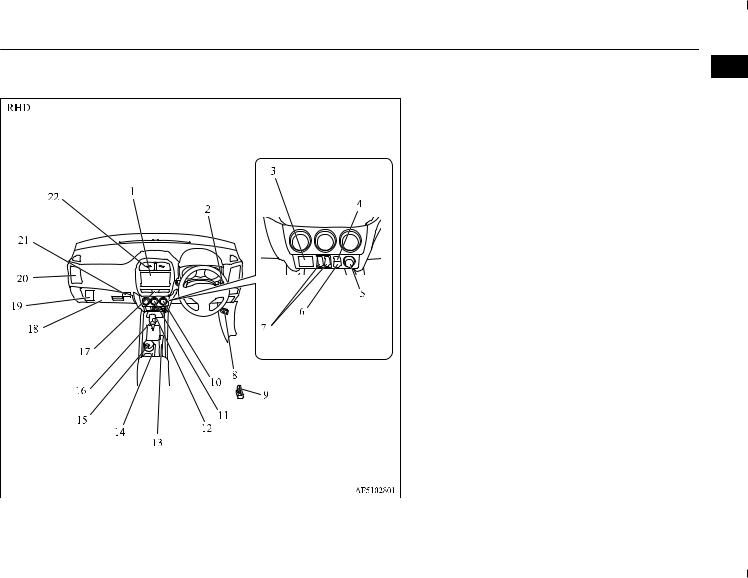
Instruments and controls
1
OGAE18E1 |
1.Audio system* p. 7-11
MITSUBISHI Multi-Communication System* DISPLAY AUDIO*
Smartphone Link Display Audio* Refer to the separate owner’s manual
2.Multi-information meter switch p. 5-04
3.USB input terminal* p. 7-67
4.Active stability control (ASC) OFF switch* p. 5-04
5.Accessory Socket p. 7-72
6.Auto Stop & Go (AS&G) OFF switch* p. 6-19
7.Heated seat switch* p. 4-06
8.Bonnet release lever p. 10-03
9.Fuel tank filler door release lever p. 2-03
10.Rear window demister switch p. 5-64
11.Air conditioning* p. 7-03
12.Drive mode selector* p. 6-39
13.Parking brake lever p. 6-06
14.Cup holder p. 7-79
15.Ashtray* p. 7-71
16.Gearshift or selector lever p. 6-23, 6-26, 6-33
17.Hazard warning flasher switch p. 5-57
18.Front passenger’s airbag ON-OFF switch p. 4-27 Glove box p. 7-76
19.Fuse box p. 10-19
20.Side ventilators p. 7-02
21.Key slot* p. 3-20
22.Centre ventilators p. 7-02
Overview 1-05

|
Interior |
|
|
|
1 |
Interior |
|
|
|
|
|
|
|
E00100206660 |
|
|
|
1. |
Lock switch p. 3-40 |
|
|
|
2. |
Electric remote-controlled outside rear-view mirrors switch |
|
|
|
|
p. 6-10 |
|
|
|
3. |
Central door lock switch p. 3-26 |
|
|
|
4. |
Electric window control switch p. 3-39 |
|
|
|
5. |
Sunshade illumination dimming control switch* p. 7-75 |
|
|
|
6. |
Inside rear-view mirror p. 6-08 |
|
|
|
7. |
Front seat p. 4-03 |
|
|
|
|
Heated seat* p. 4-06 |
|
|
|
8. |
Supplemental restraint system (SRS) - side airbag (for front |
|
|
|
|
seats)* p. 4-32 |
|
|
|
9. |
Head restraints p. 4-07 |
|
|
|
10. |
Luggage room lamp p. 7-74 |
|
|
|
11. |
Luggage floor box* p. 7-78 |
|
|
|
12. |
Tether anchorages for child restraint system p. 4-22 |
|
|
|
13. |
Seat belts p. 4-09 |
|
|
|
|
Adjustable seat belt anchor p. 4-12 |
|
|
|
14. |
Supplemental restraint system (SRS) - curtain airbag* p. 4-33 |
|
1-06 |
Overview |
OGAE18E1 |
|

Interior
1
1. |
Rear shelf panel p. 7-80 |
|
2. |
Assist grip p. 7-80 |
|
|
Coat hook p. 7-81 |
|
3. |
Room lamp (rear)* p. 7-74 |
|
4. |
Sun visors p. 7-70 |
|
|
Vanity mirror p. 7-70 |
|
|
Card holder p. 7-70 |
|
5. |
Map lamp & room lamp (front) p. 7-73 |
|
|
Sunshade switch* p. 3-41 |
|
|
Microphone (for Bluetooth® 2.0 interface)* p. 7-47 |
|
6. |
Supplemental restraint system (SRS) - airbag (for front passen- |
|
|
ger’s seat) p. 4-24, 4-29 |
|
7. |
Bottle holder p. 7-79 |
|
8. |
Armrest Accessory socket p. 7-72 |
|
9. |
Rear seat p. 4-06 |
|
10. |
Armrest* p. 4-06 |
|
|
Cup holder* p. 7-79 |
|
OGAE18E1 |
Overview |
1-07 |
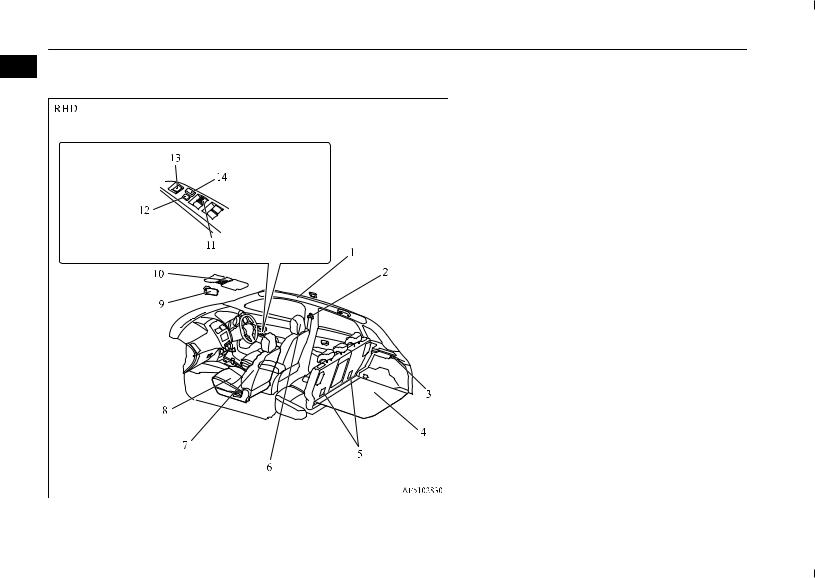
Interior |
|
|
|
1 |
|
|
|
|
|
1. |
Supplemental restraint system (SRS) - curtain airbag* p. 4-33 |
|
|
2. |
Seat belts p. 4-09 |
|
|
|
Adjustable seat belt anchor p. 4-12 |
|
|
3. |
Luggage room lamp p. 7-74 |
|
|
4. |
Luggage floor box* p. 7-78 |
|
|
5. |
Tether anchorages for child restraint system p. 4-22 |
|
|
6. |
Head restraints p. 4-07 |
|
|
7. |
Supplemental restraint system (SRS) - side airbag (for front |
|
|
|
seats)* p. 4-32 |
|
|
8. |
Front seat p. 4-03 |
|
|
|
Heated seat* p. 4-06 |
|
|
9. |
Inside rear-view mirror p. 6-08 |
|
|
10. |
Sunshade illumination dimming control switch* p. 7-75 |
|
|
11. |
Electric window control switch p. 3-39 |
|
|
12. |
Lock switch p. 3-40 |
|
|
13. |
Electric remote-controlled outside rear-view mirrors switch |
|
|
|
p. 6-10 |
|
|
14. |
Central door lock switch p. 3-26 |
1-08 |
Overview |
OGAE18E1 |
|
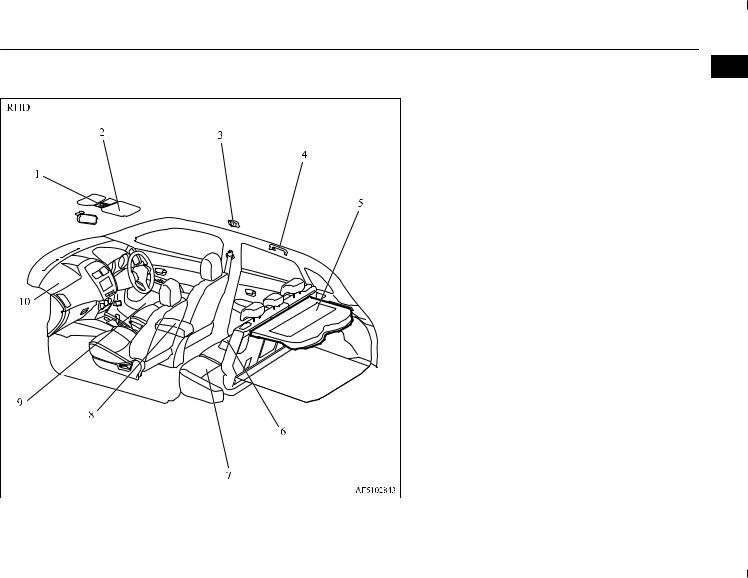
Interior
1
1. |
Map lamp & room lamp (front) p. 7-73 |
|
|
Sunshade switch* p. 3-41 |
|
|
Microphone (for Bluetooth® 2.0 interface)* p. 7-47 |
|
2. |
Sun visors p. 7-70 |
|
|
Vanity mirror p. 7-70 |
|
|
Card holder p. 7-70 |
|
3. |
Room lamp (rear)* p. 7-74 |
|
4. |
Assist grip p. 7-80 |
|
|
Coat hook p. 7-81 |
|
5. |
Rear shelf panel p. 7-80 |
|
6. |
Armrest* p. 4-06 |
|
|
Cup holder* p. 7-79 |
|
7. |
Rear seat p. 4-06 |
|
8. |
Armrest Accessory socket p. 7-72 |
|
9. |
Bottle holder p. 7-79 |
|
10. |
Supplemental restraint system (SRS) - airbag (for front passen- |
|
|
ger’s seat) p. 4-24, 4-29 |
|
OGAE18E1 |
Overview |
1-09 |

Luggage compartment
1Luggage compartment
E00100402996
|
|
1. |
Tyre repair kit p. 8-07 |
Vehicle with tyre repair kit |
2. Luggage hook p. 7-81 |
||
|
|
3. |
Jack p. 8-07 |
|
|
4. |
Tools p. 8-06 |
|
|
5. |
Luggage hook p. 7-81 |
|
|
6. |
Hook |
|
|
7. |
Luggage hook p. 7-81 |
|
|
8. |
Tools p. 8-06 |
1-10 |
Overview |
OGAE18E1 |
|

Luggage compartment
1
Vehicle with the spare tyre |
1. |
Spare wheel p. 8-14 |
|
2. Luggage hook p. 7-81 |
|
||
|
3. |
Jack p. 8-07 |
|
|
4. |
Tools p. 8-06 |
|
|
5. |
Luggage hook p. 7-81 |
|
|
6. |
Hook |
|
|
7. |
Luggage hook p. 7-81 |
|
|
8. |
Tools p. 8-06 |
|
|
OGAE18E1 |
Overview |
1-11 |

|
Exterior |
|
|
|
1 |
Exterior |
|
|
|
|
|
|
|
E00100507790 |
|
|
|
1. |
Electric window control p. 3-39 |
|
|
|
2. |
Outside rear-view mirror p. 6-10 |
|
|
|
|
Side turn-signal lamps* p. 5-57, 10-26, 10-32 |
|
|
|
3. |
Fuel tank filler p. 2-03 |
|
|
|
4. |
Wheel lip molding* |
|
|
|
|
For details, refer to Vehicle dimensions p. 11-04. |
|
|
|
5. |
Position lamps (Type 1)* p. 5-50, 10-26, 10-30 |
|
|
|
6. |
Headlamps, low beam p. 5-50, 10-26, 10-28, 10-29 |
|
|
|
7. |
Front fog lamps* p. 5-58, 10-26, 10-32 |
|
|
|
8. |
Daytime running lamps* p. 5-53, 10-26, 10-33 |
|
|
|
|
Position lamps (Type 2)* p. 5-53, 10-26, 10-33 |
|
|
|
9. |
Headlamps, high-beam p. 5-50, 10-26, 10-29 |
|
|
|
10. |
Front turn-signal lamps p. 5-57, 10-26, 10-31 |
|
|
|
11. |
Bonnet p. 10-03 |
|
|
|
12. |
Windscreen wipers p. 5-59 |
|
|
|
13. |
Sensor* [for Forward Collision Mitigation system (FCM) and |
|
|
|
|
Lane Departure Warning (LDW)] p. 6-59, 6-68 |
|
|
|
|
Rain sensor* p. 5-60 |
|
|
|
14. |
Side turn-signal lamps* p. 5-57, 10-26, 10-32 |
|
1-12 |
Overview |
OGAE18E1 |
|

Exterior
1
1. |
Keyless entry system* p. 3-04, 3-22 |
|
|
Keyless operation system* p. 3-07 |
|
|
Locking and unlocking the doors p. 3-25 |
|
2. |
Changing tyres p. 8-13 |
|
|
Tyre inflation pressures p. 10-13 |
|
|
Tyre rotation p. 10-15 |
|
|
Tyre chains p. 10-16 |
|
|
Size of tyres and wheels p. 11-12 |
|
|
Tyre pressure monitoring system* p. 6-71 |
|
3. |
Rear turn-signal lamps/Hazard warning lamps p. 5-57, 5-57, |
|
|
10-26, 10-34 |
|
4. |
Stop lamps/Tail lamps p. 5-50, 10-26, 10-34 |
|
5. |
Corner sensors* p. 6-77 |
|
6. |
Reversing lamps p. 10-26, 10-34 |
|
7. |
Back sensors* p. 6-77 |
|
8. |
Corner sensors* p. 6-77 |
|
9. |
Rear fog lamp* p. 5-58, 10-26, 10-34 |
|
10. |
Licence plate lamps p. 5-50, 10-26, 10-35 |
|
11. |
Rear-view camera* p. 6-81 |
|
12. |
Rear window wiper p. 5-63 |
|
13. |
Rear spoiler |
|
14. |
High-mounted stop lamp p. 10-26 |
|
15. |
Antenna |
|
16. |
Tailgate p. 3-30 |
|
OGAE18E1 |
Overview |
1-13 |
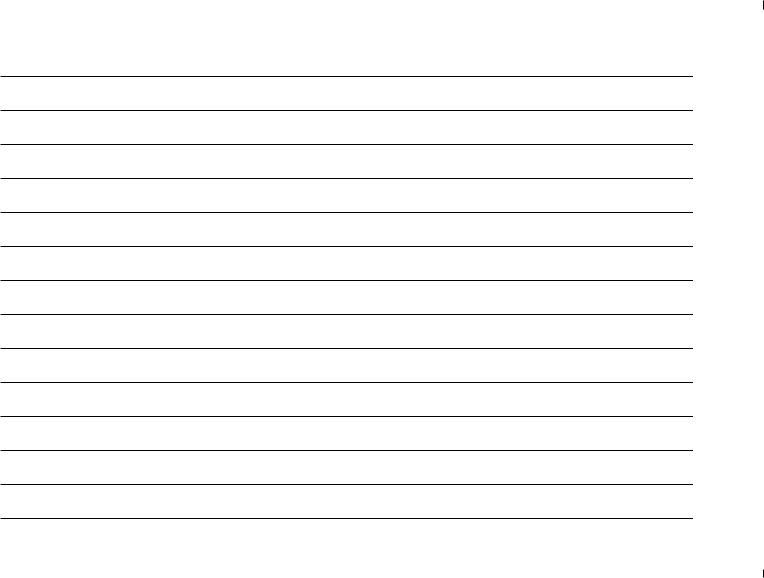
OGAE18E1

General information
2
Fuel selection...................................................................................... |
2-02 |
Filling the fuel tank............................................................................. |
2-03 |
Installation of accessories................................................................... |
2-05 |
Modification/alterations to the electrical or fuel systems................... |
2-06 |
Genuine parts...................................................................................... |
2-06 |
Safety and disposal information for used engine oil........................... |
2-06 |
Disposal information for used batteries.............................................. |
2-07 |
Auto Stop & Go (AS&G) system*..................................................... |
2-07 |
OGAE18E1

Fuel selection
Fuel selection
2 |
|
|
E00200105113 |
|
|
|
|
|
|
|
|
|
|
|
Petrol-powered vehicles |
|
|
|
|
|
|
|
Unleaded petrol octane |
|
|
|
number (EN228) |
|
|
|
1600 models |
|
|
Recom- |
95 RON or higher |
|
|
mended |
2000 models |
|
|
fuel |
90 RON or higher |
|
|
|
Diesel-powered vehicles |
|
|
|
Cetane number (EN590) |
|
|
|
51 or higher |
|
|
|
|
 CAUTION
CAUTION
• For petrol-powered vehicles, the use of leaded fuel can result in serious damage to the engine and catalytic converter. Do not use leaded fuel.
• Diesel-powered vehicles are designed to use only diesel fuel that meets the EN 590 standard.
Use of any other type of diesel fuel (bio diesel, methyl ester, etc.) would adversely affect the engine’s performance and durability.
 NOTE
NOTE
•Petrol-powered vehicles have the knock control system so that you can use unleaded petrol 90 RON as an emergent measure in case unleaded petrol 95 RON or higher is not available on journey, etc.
In such a case, you don’t need to adjust the engine specially. In case of using unleaded petrol 90 RON, the engine performance level is reduced.
•For diesel fuel, due to the separation of paraffin, the fluidity of the fuel decreases considerably as the temperature falls.
Because of this fact there are two kinds of fuel: “summer” and “winter”.
This must be considered in winter use. Select either of the two kinds of fuel in accordance with ambient temperature.
Above -5 °C: “Summer” diesel Below -5 °C: “Winter” diesel
When travelling abroad, find out in advance about the fuels served in local service stations.
 NOTE
NOTE
• Repeatedly driving short distances at low speeds can cause deposits to form in the fuel system and engine, resulting in poor starting and poor acceleration. If these problems occur, you are advised to add a detergent additive to the gasoline when you refuel the vehicle. The additive will remove the deposits, thereby returning the engine to a normal condition. Be sure to use a MITSUBISHI MOTORS GENUINE FUEL SYSTEM CLEANER. Using an unsuitable additive could make the engine malfunction. For details, please contact a MITSUBISHI MOTORS Authorized Service Point.
• Poor quality petrol can cause problems such as difficult starting, stalling, engine noise and hesitation. If you experience these problems, try another brand and/or grade of petrol.
If the check engine warning lamp flashes, have the system checked as soon as possible at a MITSUBISHI MOTORS Authorized Service Point.
2-02 |
General information |
OGAE18E1 |

Filling the fuel tank
Graphical expression for consumer information
Identifier for petrol-type fuels
E5: Petrol fuel containing up to 2.7 % (m/m) oxygen or up to 5.0 % (V/V) ethanol – Eg. EN 228 compliant unleaded petrol
E10: Petrol fuel containing up to 3.7 % (m/m) oxygen or up to 10.0 % (V/V) ethanol
– Eg. EN 228 compliant unleaded petrol
The petrol engine are compatible with E5 type petrol (containing 5 % ethanol) and E10 type petrol (containing 10 % ethanol) conforming to European standards EN 228.
 CAUTION
CAUTION
Do not use more than 10 % concentration of ethanol (grain alcohol) by volume.
Use of more than 10 % concentration may lead to damage to your vehicle fuel system, engine, engine sensors and exhaust system.
Identifier for diesel-type fuels
B7: Diesel fuel containing up to 7.0 % (V/V) Fatty Acid Methyl Esters – Eg. EN 590 compliant diesel
The diesel engine are compatible with B7 type diesel (containing 7 % fatty acid methyl esters) conforming to European standards EN590.
 CAUTION
CAUTION
Do not use more than 7 % concentration of fatty acid methyl esters (bio diesel) by volume.
Use of more than 7 % concentration would adversely affect the engine’s performance and durability.
Filling the fuel tank
E00200204289
 WARNING
WARNING
•When handling fuel, comply with the safety regulations displayed by garages and filling stations.
WARNING |
|
|
|
|
||
• Gasoline is highly flammable and explo- |
|
|
||||
|
2 |
|||||
sive. You could be burned or seriously in- |
|
|||||
|
||||||
jured when handling it. When refueling |
|
|
||||
your vehicle, always turn the engine off |
|
|
||||
and keep away from flames, sparks, and |
|
|
||||
smoking materials. Always handle fuel in |
|
|
||||
well-ventilated outdoor areas. |
|
|
||||
• Before removing the fuel cap, be sure to |
|
|
||||
get rid of your body’s static electricity by |
|
|
||||
touching a metal part of the car or the |
|
|
||||
fuel pump. Any static electricity on your |
|
|
||||
body could create a spark that ignites fuel |
|
|
||||
vapour. |
|
|
|
|
|
|
• Perform |
the whole |
refueling process |
|
|
||
(opening the fuel tank filler door, remov- |
|
|
||||
ing the fuel cap, etc.) by yourself. Do not |
|
|
||||
let any other person come near the fuel |
|
|
||||
tank filler. If you allowed a person to help |
|
|
||||
you and that person was carrying static |
|
|
||||
electricity, fuel vapour could be ignited. |
|
|
||||
• Do not move away from the fuel tank fill- |
|
|
||||
er until refueling is finished. If you moved |
|
|
||||
away and did something else (for exam- |
|
|
||||
ple, sitting on a seat) part-way through |
|
|
||||
the refueling process, you could pick up a |
|
|
||||
fresh charge of static electricity. |
|
|
||||
• If the tank cap must be replaced, use only |
|
|
||||
a MITSUBISHI MOTORS genuine part. |
|
|
||||
Fuel tank capacity |
|
|
|
|
||
|
|
|
|
|||
|
|
|
|
|
|
|
|
|
|
|
|
|
|
Petrol-pow- |
2WD models |
|
63 litres |
|
|
|
ered vehi- |
|
|
|
|
|
|
4WD models |
|
60 litres |
|
|
||
cles |
|
|
|
|
|
|
OGAE18E1 |
General information |
2-03 |
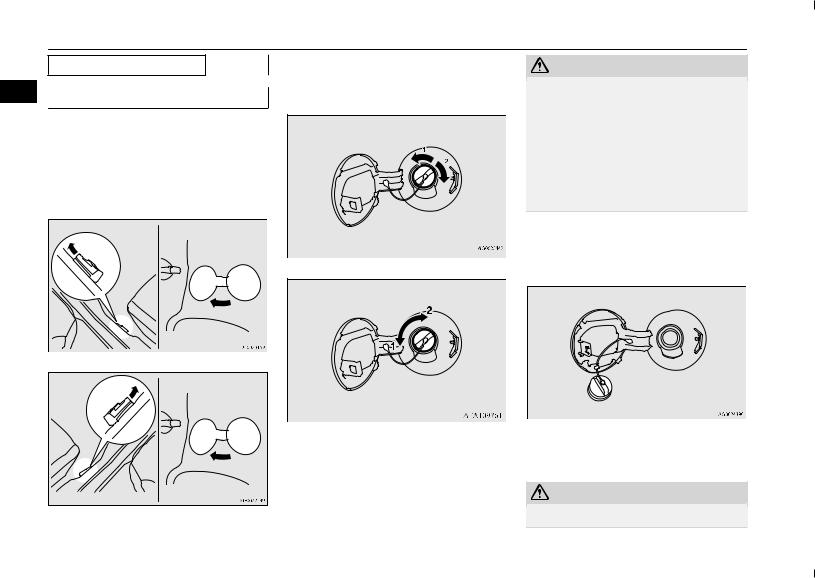
Filling the fuel tank
|
Diesel-powered vehicles |
60 litres |
3. Remove the fuel cap. |
CAUTION |
2 |
|
|
Open the fuel tank filler tube by slowly |
• For diesel-powered 1600 models, the fuel |
Refueling |
|
turning the cap anticlockwise. |
||
|
cap does not turn more than 90 degrees. |
|||
|
1. Before filling with fuel, stop the engine. |
|
Turning forcibly could damage the fuel cap. |
|
|
Except for diesel-powered vehicles 1600 models |
• Since the fuel system may be under pressure, |
||
|
2. The fuel tank filler is located on the rear |
|
remove the fuel cap slowly. This relieves |
|
|
left side of your vehicle. |
|
|
any pressure or vacuum that might have |
|
Open the fuel tank filler door by pulling |
|
built up in the fuel tank. If you hear a hissing |
|
|
the release lever located on the side of |
|
sound from the cap, wait until it stops before |
|
|
|
removing the cap. Otherwise, fuel may spray |
||
|
the driver’s seat. |
|
|
|
|
|
|
out, injuring you or others. |
|
|
|
|
|
|
|
LHD |
|
|
4. While filling with fuel, hang the fuel cap |
|
|
|
|
|
|
|
|
|
cord on the hook located on the inside of |
|
|
|
|
the fuel tank filler door. |
|
|
|
Diesel-powered vehicles 1600 models |
|
RHD
1- Remove |
|
5. Insert the gun in the tank port as far as it |
|
||
2- Close |
|
goes. |
|
|
CAUTION |
|
|
• Do not tilt the gun. |
2-04 |
General information |
OGAE18E1 |

|
|
|
|
|
|
|
|
|
|
Installation of accessories |
|
|||
|
|
|
|
|
|
|
|
|
||||||
6. When the gun stops automatically, do |
|
|
|
|
|
|
|
• When installing the radio, for the re- |
|
|||||
CAUTION |
|
|
|
|
||||||||||
not fill with fuel any more. |
|
|
|
|
|
|
|
quired information (frequency, transmis- |
|
|||||
• Your vehicle is equipped with a diagnosis |
|
|||||||||||||
7. Close the fuel cap. |
|
sion output, installing procedure), con- |
2 |
|||||||||||
[Except for |
diesel-powered vehicles |
connector for checking and servicing the |
|
sult a MITSUBISHI MOTORS Author- |
||||||||||
|
|
|||||||||||||
electronic control system. |
|
|
|
|
||||||||||
1600 models] |
|
|
|
|
|
ized Service Point. |
|
|||||||
|
|
Do not connect a device other than a diagno- |
|
|
||||||||||
To close, turn the fuel cap slowly clock- |
|
If the frequency, transmission output and |
|
|||||||||||
sis tool for inspections and service to this |
|
|
||||||||||||
wise until you hear clicking sounds, then |
connector. Otherwise, the battery could be |
|
installing condition are not appropriate, |
|
||||||||||
gently push the fuel tank filler door |
discharged, the electronic devices of the ve- |
|
it can adversely affect the electronic de- |
|
||||||||||
closed. |
|
|
hicle could malfunction, or other unexpected |
|
vices and could lead to unsafe vehicle |
|
||||||||
[For diesel-powered 1600 models] |
problems could result. |
|
|
|
operation. |
|
||||||||
Fit the fuel cap with the cap handle side- |
In addition, malfunctions caused by connect- |
|
• Using a cellular phone or radio set inside |
|
||||||||||
ing a device other than a diagnosis tool may |
|
|
||||||||||||
ways and turn it clockwise. |
|
the vehicle without an external antenna |
|
|||||||||||
not be covered under warranty. |
|
|
|
|
||||||||||
|
|
|
|
|
|
may cause electrical system interference, |
|
|||||||
|
|
|
|
|
|
|
|
|
|
|
||||
|
|
|
|
|
|
|
|
|
|
which could lead to unsafe vehicle oper- |
|
|||
Installation of accessories |
|
• The installation of accessories, optional |
|
|||||||||||
|
|
ation. |
|
|||||||||||
|
|
|
parts, |
etc., |
should |
only be |
carried |
out |
|
|
||||
|
E00200302358 |
|
|
• Tyres and wheels which do not meet |
|
|||||||||
We recommend |
you to consult your |
within |
the |
limits |
prescribed |
by law |
in |
|
|
|||||
|
specifications must not be used. |
|
||||||||||||
your country, and in accordance with the |
|
|
||||||||||||
MITSUBISHI MOTORS Authorized Service |
|
Refer to the “Specifications” section for |
|
|||||||||||
guidelines and warnings contained with- |
|
|
||||||||||||
Point. |
|
|
|
information regarding wheel and tyre |
|
|||||||||
|
|
in the documents accompanying this ve- |
|
|
||||||||||
|
|
|
|
sizes. |
|
|||||||||
|
|
|
hicle. |
|
|
|
|
|
|
|
||||
|
|
|
|
|
|
|
|
|
|
|
|
|
|
|
|
|
|
• Installing electric components incorrect- |
Important points! |
|
|
|
|
||||||
|
|
|
|
|
||||||||||
|
|
|
ly could lead to a fire. See the “Modifi- |
|
|
|
|
|
|
|||||
|
|
|
|
|
|
|
|
|
||||||
|
|
|
cation/ alterations to the electrical or fuel |
|
Due to large number of accessory and re- |
|
||||||||
|
|
|
systems” section within this owner’s |
|
placement parts of different manufactures |
|
||||||||
|
|
|
manual. |
|
|
|
|
available in the market, it is not possible, not |
|
|||||
only for MITSUBISHI MOTORS, but also for a MITSUBISHI MOTORS Authorized Service Point, to check whether the attachment or installation of such parts affects the overall safety of your MITSUBISHI-vehicle.
OGAE18E1 |
General information |
2-05 |
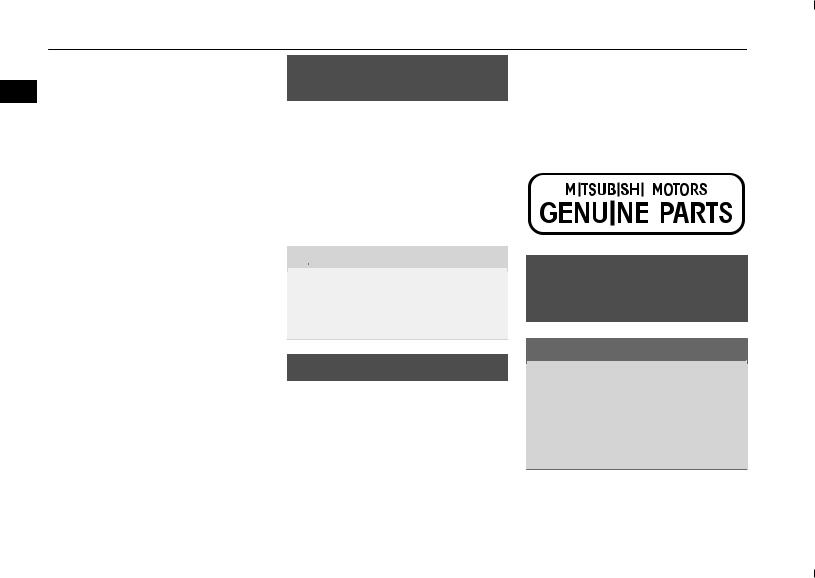
Modification/alterations to the electrical or fuel systems
Even when such parts are officially authorized, for example by a “general operators
2permit” (an appraisal for the part) or through the execution of the part in an officially approved manner of construction, or when a single operation permit following the attachment or installation of such parts, it cannot be deduced from that alone, that the driving safety of your vehicle has not been affected.
Consider also that there basically exists no liability on the part of the appraiser or the official. Maximum safety can only be ensured with parts recommended, sold and fitted or installed by a MITSUBISHI MOTORS Authorized Service Point (MITSUBISHI MOTORS genuine replacement parts and MITSUBISHI MOTORS accessories). The same also pertains to modifications of MITSUBISHI vehicles with respect to the production specifications. For safety reasons, do not attempt any modifications other than those that follow the recommendations of a MITSUBISHI MOTORS Authorized Service Point.
Modification/alterations to the electrical or fuel systems
E00200400368
MITSUBISHI MOTORS CORPORATION has always manufactured safe, high quality vehicles. In order to maintain this safety and quality, it is important that any accessory that is to be fitted, or any modifications carried out which involve the electrical or fuel systems, should be carried out in accordance with MITSUBISHI guidelines.
 CAUTION
CAUTION
• If the wires interfere with the vehicle body or improper installation methods are used (protective fuses not included, etc.), electronic devices may be adversely affected, resulting in a fire or other accident.
Genuine parts
E00200500499
MITSUBISHI MOTORS has gone to great lengths to bring you a superbly crafted automobile offering the highest quality and dependability.
Use MITSUBISHI MOTORS Genuine Parts, designed and manufactured to maintain your MITSUBISHI MOTORS automobile at top performance. MITSUBISHI MOTORS Genuine Parts are identified by this mark and are available at all MITSUBISHI MOTORS Authorized Service Points.
Safety and disposal information for used engine oil
E00200600155
 WARNING
WARNING
• Prolonged and repeated contact may cause serious skin disorders, including dermatitis and cancer.
• Avoid contact with the skin as far as possible and wash thoroughly after any contact.
• Keep used engine oils out of reach of children.
2-06 |
General information |
OGAE18E1 |

Disposal information for used batteries
Protect the environment
It is illegal to pollute drains, water courses and soil. Use authorized waste collection facilities, including civic amenity sites and garages providing facilities for disposal of used oil and used oil filters. If in doubt, contact your local authority for advice on disposal.
Disposal information for used batteries
E00201300032
Your vehicle contains batteries and/or accumulators.
Do not mix with general household waste.
For proper treatment, recovery and recycling of used batteries, please take them to applicable collection points, in accordance with your national legislation and the Directives 2006/66/EC.
By disposing of these batteries correctly, you will help to save valuable resources and prevent any potential negative effects on human health and the environment which could otherwise arise from inappropriate waste handling.
Auto Stop & Go (AS&G) system*
E00201501057
This paragraph summarizes the major items of the Auto Stop & Go (AS&G) system such as the characteristics, operating procedures, etc. For details, refer to “Auto Stop & Go (AS&G) system” on page 6-19.
The AS&G system reduces the emission of exhaust gases and increases fuel efficiency. The AS&G system automatically stops and restarts the engine without the use of the ignition switch or the engine switch when the vehicle is stopped, such as at traffic lights or in a traffic jam.
Activation
E00201601061
The AS&G system is automatically activated when the ignition switch is turned to the “ON” position or the operation mode is put in ON.
Deactivation
E00201701091 |
2 |
You can deactivate the system by pressing |
the “AS&G OFF” switch. Then the “

 ” display/indicator will turn on.
” display/indicator will turn on.
Type 1 |
Type 2 |
Auto stop
E00201801106
1. Stop the vehicle.
OGAE18E1 |
General information |
2-07 |

Auto Stop & Go (AS&G) system* |
|
|
|
|
|
2. Place the gearshift lever in the “N” |
Auto go |
|
Circumstances when the engine |
||
(Neutral) position. |
|
|
|
|
will restart by itself |
2 |
|
|
|
E00201901077 |
|
|
|
Depress the clutch pedal while the gearshift |
E00202400027 |
||
Vehicles with 5M/T |
Vehicles with 6M/T |
|
lever is in the “N” (Neutral) position. The |
• The interior temperature rises and the air |
|
|
|
|
“ ” display/indicator |
turns off and the en- |
conditioning starts operating in order to |
|
|
|
gine restarts automatically. |
lower the temperature. |
|
|
|
|
|
|
• Electric power consumption is high. |
|
|
|
|
|
• The brake pedal is depressed repeatedly. |
|
|
|
|
|
• Vehicle speed is 3 km/h (2 mph) or |
|
|
|
|
|
higher when coasting on a slope. |
|
|
|
|
|
• Mode selection dial is set to the demister |
|
|
|
|
|
position. |
|
|
|
Type 1 |
Type 2 |
• When the air conditioning is operated by |
3. Release the clutch pedal. |
|
pressing the air conditioning switch. |
|||
|
|
|
|||
4. The “ ” display/indicator will turn |
on |
|
|
• When the preset temperature of the air |
|
and the engine will stop automatically. |
|
|
conditioning is changed significantly. |
||
|
|
|
|
|
• When the air conditioning is operated in |
|
|
|
|
|
AUTO mode where the temperature con- |
|
|
|
|
|
trol dial is set to the max. hot or the max. |
|
|
|
|
|
cool position (for vehicles with automat- |
|
|
|
|
|
ic air conditioning). |
|
|
System characteristics |
Other than the conditions mentioned above, |
Type 1 |
Type 2 |
E00202301065 |
the engine may restart automatically. For de- |
|
|
The principle of the AS&G system is that it |
tails, refer to “Auto Stop & Go (AS&G) sys- |
|
|
adapts to the vehicle’s needs (i.e. energy sup- |
tem” on page 6-19. |
|
|
ply). This means that in certain circumstances |
Circumstances when the engine |
|
|
the engine will not stop and in other circum- |
|
|
|
stances the engine will restart by itself. |
will not stop |
|
|
|
E00202501054 |
|
|
|
• Ambient temperature is low. |
2-08 |
General information |
OGAE18E1 |
|
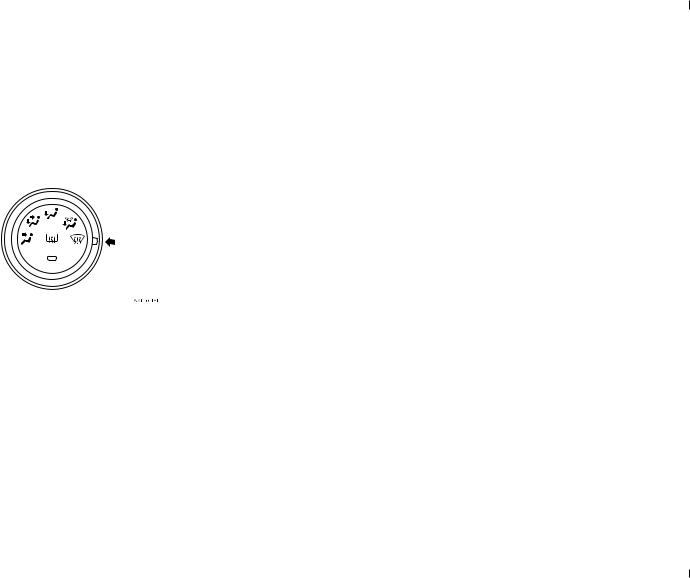
|
|
Auto Stop & Go (AS&G) system* |
||
|
|
|
|
|
• After the engine restarts automatically |
|
|
|
|
and the vehicle stops again within 10 |
|
|
|
|
seconds. |
|
2 |
||
• After the engine restarts automatically |
|
|
|
|
and the vehicle remains stationary. |
|
|
|
|
• Mode selection dial is set to the demister |
|
|
|
|
position (see illustration below). |
|
|
|
|
|
|
|
|
|
|
|
|
|
|
• When the air conditioning is operated in AUTO mode where the temperature control dial is set to the max. hot or the max. cool position (for vehicles with automatic air conditioning).
Other than the conditions mentioned above, the engine may not stop automatically. For details, refer to “Auto Stop & Go (AS&G) system” on page 6-19.
OGAE18E1 |
General information |
2-09 |

OGAE18E1

Locking and unlocking
3
Keys.................................................................................................... |
3-02 |
Electronic immobilizer (Anti-theft starting system)........................... |
3-03 |
Keyless entry system*......................................................................... |
3-04 |
Keyless operation system*.................................................................. |
3-07 |
Doors................................................................................................... |
3-25 |
Central door locks............................................................................... |
3-26 |
Dead Lock System*............................................................................ |
3-27 |
“Child-protection” rear doors.............................................................. |
3-30 |
Tailgate................................................................................................ |
3-30 |
Inside tailgate release.......................................................................... |
3-31 |
Security alarm system*....................................................................... |
3-32 |
Electric window control...................................................................... |
3-39 |
Sunshade*........................................................................................... |
3-41 |
OGAE18E1
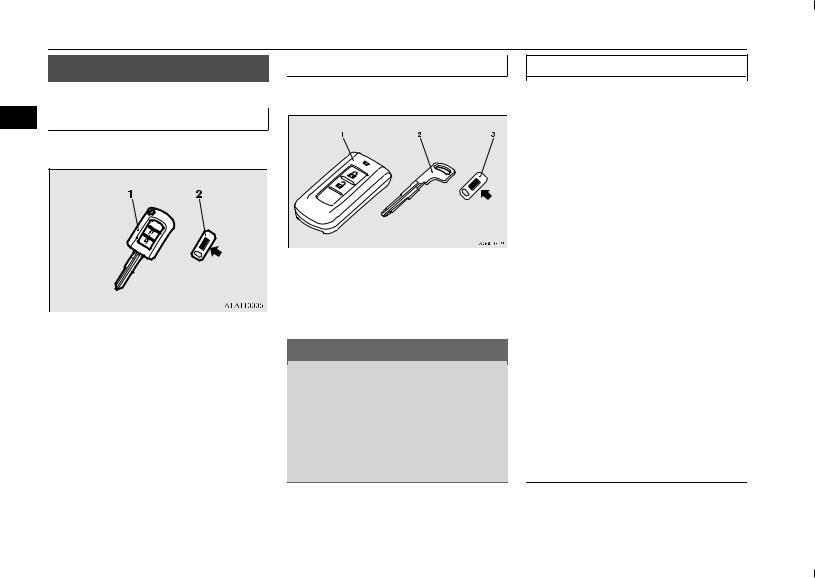
Keys
Keys Type 2
E00300104087 |
The emergency key fits all locks. |
|
3Type 1
The key fits all locks.
1- Keyless entry key
(with electronic immobilizer) 2- Key number tag
1- Keyless operation key
(with electronic immobilizer and keyless entry system function)
2- Emergency key
3- Key number tag
 WARNING
WARNING
•When taking a key on flights, do not press any switches on the key while on the plane. If a switch is pressed on the plane, the key emits electromagnetic waves, which could adversely affect the plane’s flight operation.
When carrying a key in a bag, be careful that no switches on the key can be easily pressed by mistake.
 NOTE
NOTE
• The key number is stamped on the tag as indicated in the illustration.
Make a record of the key number and store the key and key number tag in separate places, so that you can order a key in the event the original keys are lost.
•The key is a precision electronic device with a built-in signal transmitter. Please observe the following in order to prevent a malfunction.
•Do not leave in a place that is exposed to direct sunlight, for example on the dashboard.
•Do not disassemble or modify.
•Do not excessively bend the key or subject it to a strong impacts.
•Do not expose to water.
•Keep away from magnetic key rings.
•Keep away from audio systems, personal computers, TVs, and other equipment that generates a magnetic field.
•Keep away from devices that emit strong electromagnetic waves, such as cellular phones, wireless devices and high frequency equipment (including medical devices).
•Do not clean with ultrasonic cleaners or similar equipment.
•Do not leave the key where it may be exposed to high temperature or high humidity.
3-02 |
Locking and unlocking |
OGAE18E1 |
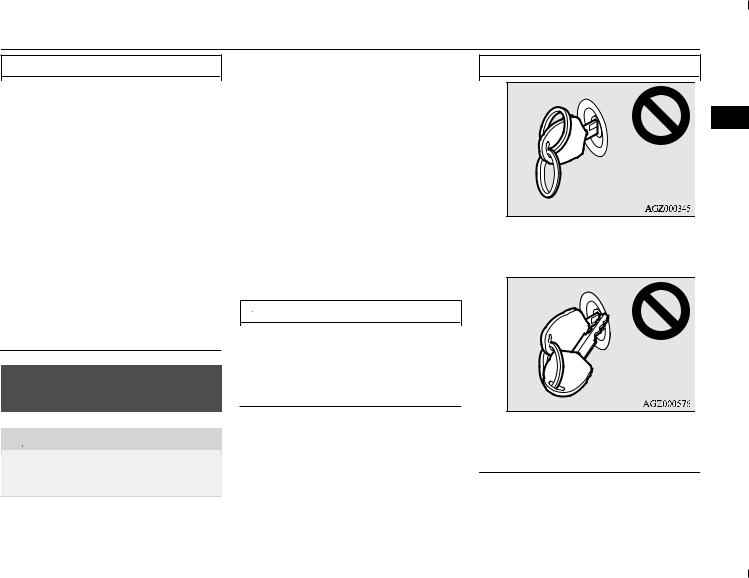
Electronic immobilizer (Anti-theft starting system)
 NOTE
NOTE
• The engine is designed so that it will not start if the ID code registered in the immobilizer computer and the key’s ID code do not match. Refer to the “Electronic immobilizer” section for details and key usage.
• [For vehicles equipped with the security alarm system]
Pay attention to the following if the security alarm is set to “Active”.
Refer to “Security alarm system” on page 3-32.
•If the security alarm is in the system armed mode, the alarm will sound if the doors are opened after being unlocked with the key, the inside lock knob or the central door lock switch.
•Even if the security alarm is set to “Active”, the system preparation mode is not entered if the keyless entry system or the keyless operation function was not used to lock the vehicle.
Electronic immobilizer (Anti-theft starting system)
E00300203805
 CAUTION
CAUTION
•Do not modify or add parts to the immobilizer system. Doing so could cause the immobilizer to malfunction.
[For vehicles equipped with keyless operation system]
For information on operations for vehicles equipped with the keyless operation system, refer to “Keyless operation system: Electronic immobilizer (Anti-theft starting system)” on page 3-12.
[Except vehicles equipped with keyless operation system]
The electronic immobilizer has been designed to significantly reduce the possibility of vehicle theft. The purpose of the system is to immobilize the vehicle if an invalid start is attempted. A valid start attempt can only be achieved by using a key “registered” to the immobilizer system.
 NOTE
NOTE
• In the following cases, the vehicle may not be able to receive the registered ID code from the registered key and the engine may not start.
•When the key contacts a key ring or other metallic or magnetic object.
 NOTE
NOTE
3
•When the key grip contacts metal of another key.
•When the key contacts or is close to other immobilizing keys (including keys of other vehicles).
OGAE18E1 |
Locking and unlocking |
3-03 |

Keyless entry system*
 NOTE
NOTE
3
In cases like these, remove the object or additional key from the vehicle key. Then try again to start the engine. If the engine does not start, we recommend you to contact your MITSUBISHI MOTORS Authorized Service Point.
• If you lose one of them, contact a MITSUBISHI MOTORS Authorized Service Point as soon as possible. To obtain a replacement or extra spare key, take your vehicle and all remaining keys to your MITSUBISHI MOTORS Authorized Service Point. All the keys have to be re-regis- tered in the immobilizer computer unit. The immobilizer can register up to 8 different keys.
Keyless entry system*
E00300304425
Press the remote control switch, and all doors and the tailgate will be locked or unlocked as desired. It is also possible to operate the outside rear-view mirrors (Vehicles equipped with the mirror retractor switch).
1- LOCK switch
2- UNLOCK switch
3- Indication lamp
To lock
Press the LOCK switch (1). All the doors and the tailgate will be locked. The turn-signal lamps will blink once when the doors and the tailgate are locked.
 NOTE
NOTE
•With a vehicle that has a Dead Lock System, pressing the LOCK switch (1) two times in succession causes the Dead Lock System to be set. (Refer to “Setting the system” on page 3-27.)
To unlock
Press the UNLOCK switch (2). All the doors and the tailgate will be unlocked. If the doors and tailgate are unlocked when the front room lamp switch is in the “DOOR” position or the rear room lamp switch (except for vehicles equipped with the sunshade) is in the middle (•) position, the room lamp will illuminate for approximately 15 seconds and the turn-signal lamps will blink twice.
Depending on the vehicle model, the position and tail lamps can also be set to turn on for approximately 30 seconds. Refer to “Instruments and controls: Welcome light” on page 5-54.
 NOTE
NOTE
• The remote control switch does not operate in the following conditions:
•The key is left in the ignition switch.
•A door or the tailgate is open or ajar. (Only the unlock function operates.)
3-04 |
Locking and unlocking |
OGAE18E1 |
